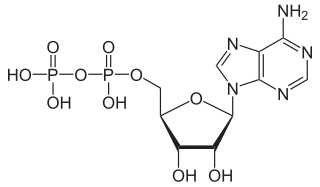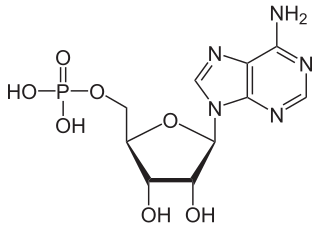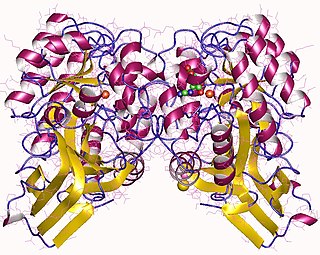Hydrolysis is any chemical reaction in which a molecule of water breaks one or more chemical bonds. The term is used broadly for substitution, elimination, and solvation reactions in which water is the nucleophile.

Adenosine diphosphate (ADP), also known as adenosine pyrophosphate (APP), is an important organic compound in metabolism and is essential to the flow of energy in living cells. ADP consists of three important structural components: a sugar backbone attached to adenine and two phosphate groups bonded to the 5 carbon atom of ribose. The diphosphate group of ADP is attached to the 5’ carbon of the sugar backbone, while the adenine attaches to the 1’ carbon.

Adenosine monophosphate (AMP), also known as 5'-adenylic acid, is a nucleotide. AMP consists of a phosphate group, the sugar ribose, and the nucleobase adenine. It is an ester of phosphoric acid and the nucleoside adenosine. As a substituent it takes the form of the prefix adenylyl-.
Translocase is a general term for a protein that assists in moving another molecule, usually across a cell membrane. These enzymes catalyze the movement of ions or molecules across membranes or their separation within membranes. The reaction is designated as a transfer from “side 1” to “side 2” because the designations “in” and “out”, which had previously been used, can be ambiguous. Translocases are the most common secretion system in Gram positive bacteria.
Carbamoyl phosphate synthetase (glutamine-hydrolysing) is an enzyme that catalyzes the reactions that produce carbamoyl phosphate in the cytosol. Its systemic name is hydrogen-carbonate:L-glutamine amido-ligase .
In enzymology, an adenosylcobyric acid synthase (glutamine-hydrolysing) (EC 6.3.5.10) is an enzyme that catalyzes the chemical reaction
In enzymology, an asparaginyl-tRNA synthase (glutamine-hydrolysing) is an enzyme that catalyzes the chemical reaction
In enzymology, a glutaminyl-tRNA synthase (glutamine-hydrolysing) is an enzyme that catalyzes the chemical reaction
In enzymology, a hydrogenobyrinic acid a,c-diamide synthase (glutamine-hydrolysing) (EC 6.3.5.9) is an enzyme that catalyzes the chemical reaction
In enzymology, a phosphate-transporting ATPase (EC 3.6.3.27) is an enzyme that catalyzes the chemical reaction

In enzymology, a vesicle-fusing ATPase (EC 3.6.4.6) is an enzyme that catalyzes the chemical reaction
In enzymology, an adenylyl-[glutamate---ammonia ligase] hydrolase (EC 3.1.4.15) is an enzyme that catalyzes the chemical reaction
The enzyme ADP-phosphoglycerate phosphatase (EC 3.1.3.28) catalyzes the reaction
In enzymology, a NAD+ glycohydrolase (EC 3.2.2.5) is an enzyme that catalyzes the chemical reaction
In enzymology, an adenosine-phosphate deaminase (EC 3.5.4.17) is an enzyme that catalyzes the chemical reaction

In enzymology, an imidazolonepropionase (EC 3.5.2.7) is an enzyme that catalyzes the chemical reaction
In enzymology, a N-formylglutamate deformylase (EC 3.5.1.68) is an enzyme that catalyzes the chemical reaction
In enzymology, a N-methylhydantoinase (ATP-hydrolysing) (EC 3.5.2.14) is an enzyme that catalyzes the chemical reaction

In enzymology, a glutamate 5-kinase is an enzyme that catalyzes the chemical reaction





